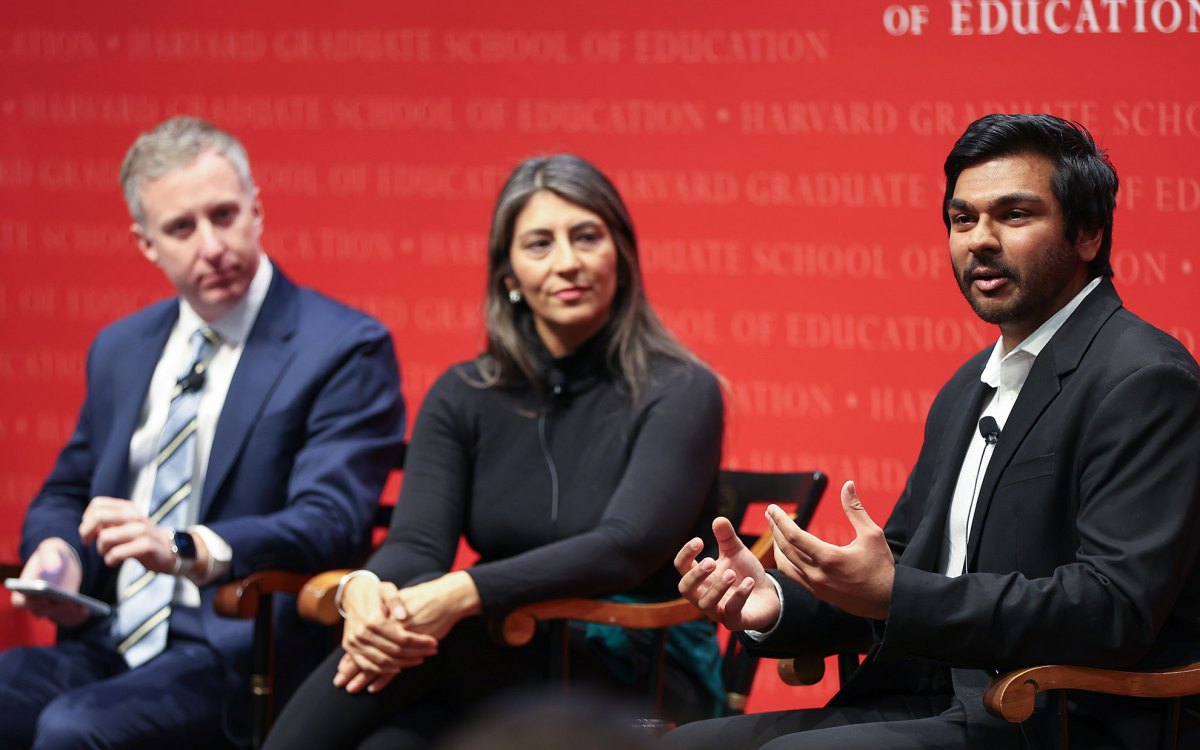
One of the basic rules of negotiation is to identify and focus on the other party’s interests, said Noam Ebner, citing Darth Vader’s inability to uncover Luke Skywalker’s interests, thus his failure to lure him to the Dark Side.
Photos by Kris Snibbe/Harvard Staff Photographer
Darth Vader had some skills. Negotiation? Not so much
Conflict-resolution experts discuss new book, which draws lessons from ‘Star Wars,’ at Law School event
In “The Empire Strikes Back,” Darth Vader, the galaxy’s greatest villain, overcomes Luke Skywalker in a lightsaber duel, reveals he is his father, and attempts to coax him over to the Dark Side. In horror, Skywalker refuses and throws himself into a chasm.
Noam Ebner and Jen Reynolds, J.D. ’07, agree that the scene is one of the most memorable in the “Star Wars” saga and pop culture, but the two conflict-resolution experts (and self-avowed fans of the goings-on in a galaxy far, far away) also view it as an illustration of key lessons on the dos and don’ts of negotiation.
Ebner, a professor of negotiation and conflict resolution at Creighton University’s Heider College of Business, and Reynolds, a professor and associate dean of faculty research and programs, University of Oregon School of Law, are contributors and co-editors of the recently published anthology “Star Wars and Conflict Resolution: There Are Alternatives to Fighting.” They discussed their collection of essays from experts in negotiation, law, business, psychology, mediation, management, and communication Tuesday in a virtual event sponsored by the Program on Negotiation at Harvard Law School.
In the iconic scene between Vader and his son, Ebner said Vader is trying to follow one of the basic rules of negotiation, according to the seminal book “Getting to Yes: Negotiating Agreement Without Giving In” by Roger Fisher and William Ury: focus on the other party’s interests, needs, and concerns, not on positions. Vader tries to persuade Luke by appealing to what he thinks are Luke’s desires. He promises that he’ll help him continue his Jedi training and bring order to the galaxy. He even offers they can rule together as father and son.
“Vader makes a very persuasive pitch to join him on the Dark Side,” said Ebner. “But Vader makes the mistake that we all often make when we assume that we know the interests of the other party and we go ahead and sort of charge forward along that path.”

According to “Getting to Yes,” one of the basic rules of negotiation is to identify and focus on the other party’s interests and avoid “positional bargaining,” in which each side starts with a position and bargains until they reach a compromise. Vader failed to uncover Luke’s interests, said Ebner.
Bargaining over positions, flexing your power, and ignoring the interests and subjective values of other party can be risky not only in “Star Wars,” but also in real life, said Reynolds. For example, when asking for a raise, it is a good idea for both parties to find out the interests or desires behind that.
“Finding out more about what’s specifically important to the person who is seeking the raise can create opportunities for a more value-rich resolution,” said Reynolds. “Failing to do this work can lead to struggling over positions, or haggling, or getting emotionally escalated, or missing integrated possibilities, winding up in an impasse and so on.”
During the webinar, Ebner and Reynolds showed scenes of “Star Wars” to explore other basic rules of negotiation: separate the people from the problem, invent options for mutual gain, use objective criteria, and consider alternatives. In one scene, Luke pleads with Jabba the Hutt to free his friend Han Solo from his Carbonite imprisonment by first showing respect for the gangster and avoiding antagonizing him in any way. In the other, Queen Amidala, who prefers diplomacy to “aggressive negotiations,” asks Boss Nass, leader of the Gungans, to cast off the uneasy relationship between their groups and form an alliance to fight off the Trade Federation’s invading army. Amidala tells Boss Nass she and her people are his “humble servants,” and she wins his support.
The “Star Wars” narrative offers many examples in which the rules of negotiation and conflict are both followed and broken. There are many instances when characters are negotiating to avoid wars or build alliances to fight common enemies, but they find themselves engulfed in conflicts again and again. It is to be expected, said Reynolds, but the epic still offers lessons on what to do, but mostly what not to do when it comes to negotiation.
“In ‘Star Wars,’ and contrary to ‘Getting to Yes,’ there’s a real tendency to focus on positions and not interests,” said Reynolds. “And this makes some sense because much of the action in ‘Star Wars’ is fighting over positions, not negotiating interests. ‘Star Wars’ is a story of good and evil, and the battle over whose governance is going to be recognized, whose vision of what the universe looks like will prevail. This is often a very positional battle …
“Again, it’s to be expected. But what is somewhat unexpected, especially for those of us who study negotiation, is that the films often critique positional stances. There are key moments in the saga where we see the problems with traditional approaches to bargaining, the overreach, and the missteps, and the backlash that positional bargaining can entail.”




